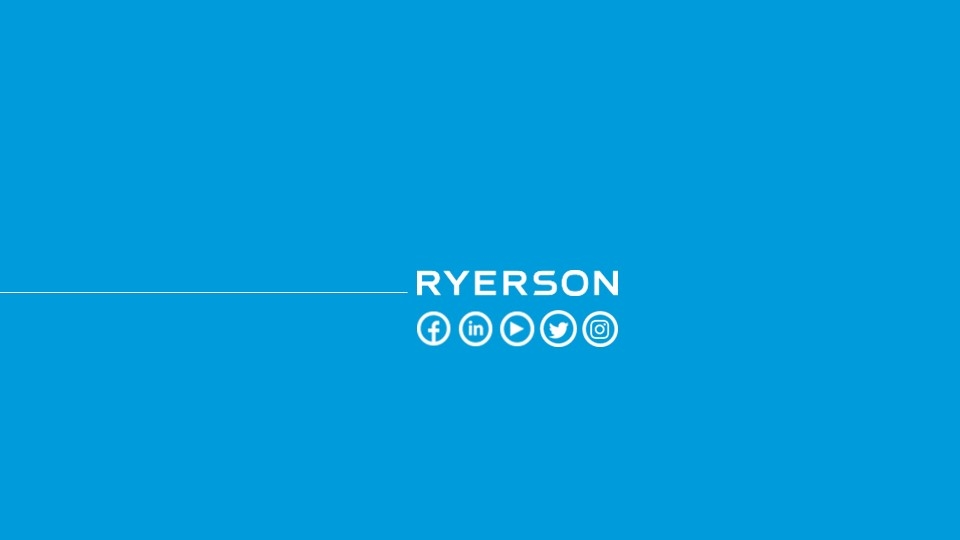Attached files
| file | filename |
|---|---|
| EX-99.1 - EX-99.1 - Ryerson Holding Corp | ryi-ex991_6.htm |
| 8-K - 8-K - Ryerson Holding Corp | ryi-8k_20200729.htm |

Ryerson Quarterly Release Presentation Q2 2020 Exhibit 99.2
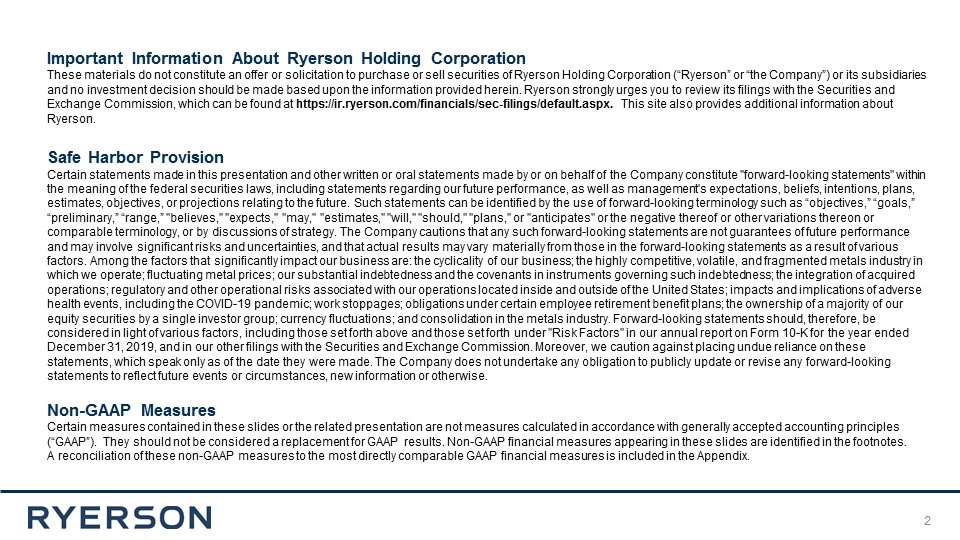
31 Important Information About Ryerson Holding Corporation These materials do not constitute an offer or solicitation to purchase or sell securities of Ryerson Holding Corporation (“Ryerson” or “the Company”) or its subsidiaries and no investment decision should be made based upon the information provided herein. Ryerson strongly urges you to review its filings with the Securities and Exchange Commission, which can be found at https://ir.ryerson.com/financials/sec-filings/default.aspx. This site also provides additional information about Ryerson. Safe Harbor Provision Certain statements made in this presentation and other written or oral statements made by or on behalf of the Company constitute "forward-looking statements" within the meaning of the federal securities laws, including statements regarding our future performance, as well as management's expectations, beliefs, intentions, plans, estimates, objectives, or projections relating to the future. Such statements can be identified by the use of forward-looking terminology such as “objectives,” “goals,” “preliminary,” “range,” "believes," "expects," "may," "estimates," "will," "should," "plans," or "anticipates" or the negative thereof or other variations thereon or comparable terminology, or by discussions of strategy. The Company cautions that any such forward-looking statements are not guarantees of future performance and may involve significant risks and uncertainties, and that actual results may vary materially from those in the forward-looking statements as a result of various factors. Among the factors that significantly impact our business are: the cyclicality of our business; the highly competitive, volatile, and fragmented metals industry in which we operate; fluctuating metal prices; our substantial indebtedness and the covenants in instruments governing such indebtedness; the integration of acquired operations; regulatory and other operational risks associated with our operations located inside and outside of the United States; impacts and implications of adverse health events, including the COVID-19 pandemic; work stoppages; obligations under certain employee retirement benefit plans; the ownership of a majority of our equity securities by a single investor group; currency fluctuations; and consolidation in the metals industry. Forward-looking statements should, therefore, be considered in light of various factors, including those set forth above and those set forth under "Risk Factors" in our annual report on Form 10-K for the year ended December 31, 2019, and in our other filings with the Securities and Exchange Commission. Moreover, we caution against placing undue reliance on these statements, which speak only as of the date they were made. The Company does not undertake any obligation to publicly update or revise any forward-looking statements to reflect future events or circumstances, new information or otherwise. Non-GAAP Measures Certain measures contained in these slides or the related presentation are not measures calculated in accordance with generally accepted accounting principles (“GAAP”). They should not be considered a replacement for GAAP results. Non-GAAP financial measures appearing in these slides are identified in the footnotes. A reconciliation of these non-GAAP measures to the most directly comparable GAAP financial measures is included in the Appendix.
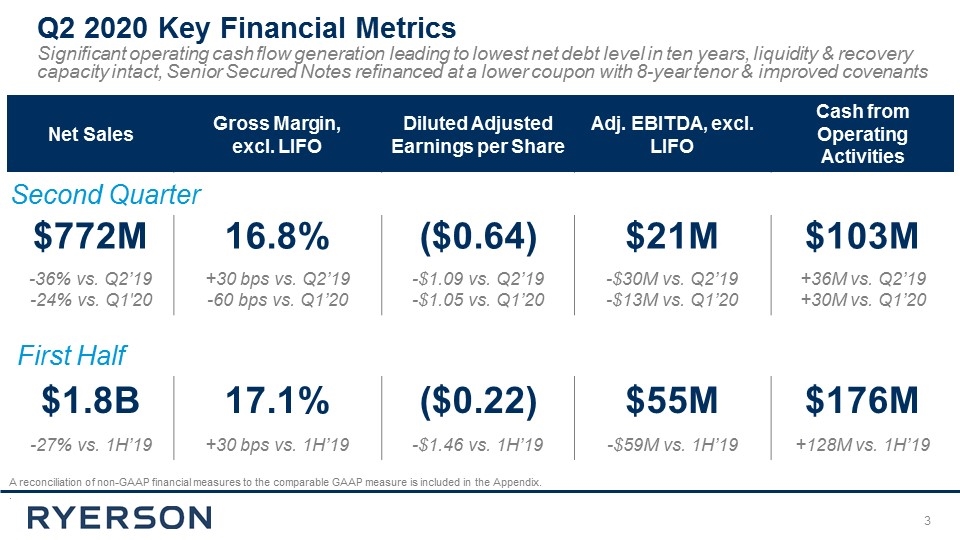
A reconciliation of non-GAAP financial measures to the comparable GAAP measure is included in the Appendix. . Net Sales Gross Margin, excl. LIFO Diluted Adjusted Earnings per Share Adj. EBITDA, excl. LIFO Cash from Operating Activities $772M 16.8% ($0.64) $21M $103M -36% vs. Q2’19 -24% vs. Q1'20 +30 bps vs. Q2’19 -60 bps vs. Q1’20 -$1.09 vs. Q2’19 -$1.05 vs. Q1’20 -$30M vs. Q2’19 -$13M vs. Q1’20 +36M vs. Q2’19 +30M vs. Q1’20 Second Quarter Q2 2020 Key Financial Metrics Significant operating cash flow generation leading to lowest net debt level in ten years, liquidity & recovery capacity intact, Senior Secured Notes refinanced at a lower coupon with 8-year tenor & improved covenants $1.8B 17.1% ($0.22) $55M $176M -27% vs. 1H’19 +30 bps vs. 1H’19 -$1.46 vs. 1H’19 -$59M vs. 1H’19 +128M vs. 1H’19 First Half
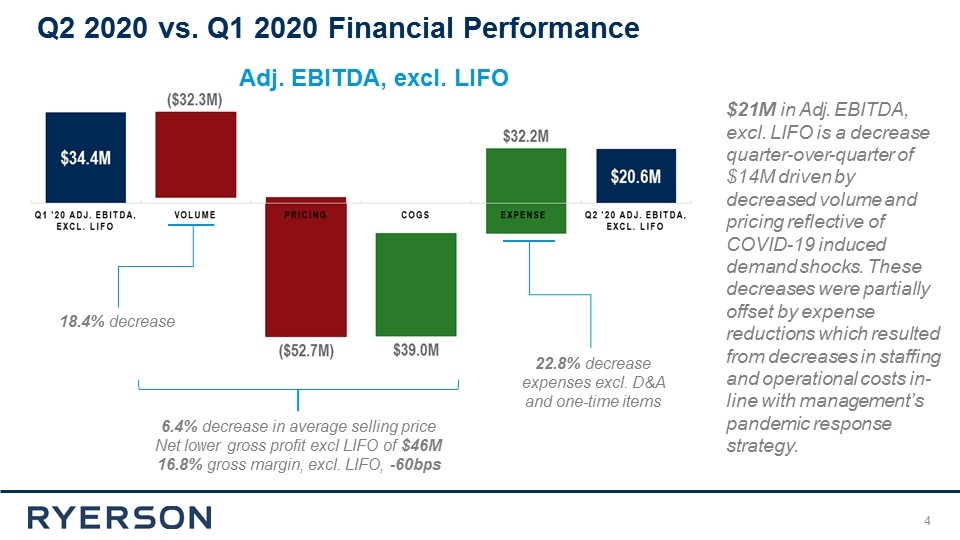
6.4% decrease in average selling price Net lower gross profit excl LIFO of $46M 16.8% gross margin, excl. LIFO, -60bps Adj. EBITDA, excl. LIFO 18.4% decrease 22.8% decrease expenses excl. D&A and one-time items $21M in Adj. EBITDA, excl. LIFO is a decrease quarter-over-quarter of $14M driven by decreased volume and pricing reflective of COVID-19 induced demand shocks. These decreases were partially offset by expense reductions which resulted from decreases in staffing and operational costs in-line with management’s pandemic response strategy. Q2 2020 vs. Q1 2020 Financial Performance
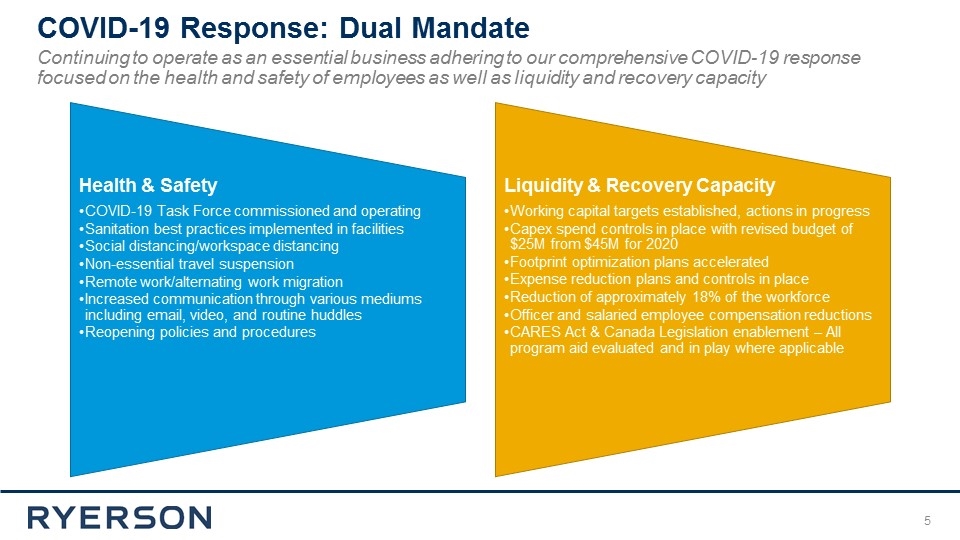
COVID-19 Response: Dual Mandate Continuing to operate as an essential business adhering to our comprehensive COVID-19 response focused on the health and safety of employees as well as liquidity and recovery capacity Health & Safety Sanitation best practices implemented in facilities Liquidity & Recovery Capacity Social distancing/workspace distancing Non-essential travel suspension Remote work/alternating work migration Increased communication through various mediums including email, video, and routine huddles Capex spend controls in place with revised budget of $25M from $45M for 2020 Expense reduction plans and controls in place Reduction of approximately 18% of the workforce CARES Act & Canada Legislation enablement – All program aid evaluated and in play where applicable Working capital targets established, actions in progress COVID-19 Task Force commissioned and operating Officer and salaried employee compensation reductions Reopening policies and procedures Footprint optimization plans accelerated
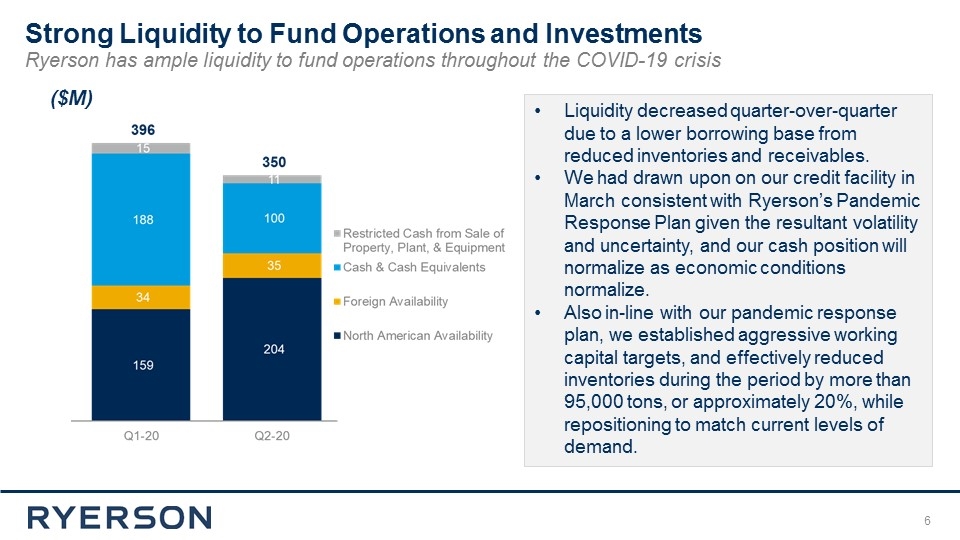
Strong Liquidity to Fund Operations and Investments Ryerson has ample liquidity to fund operations throughout the COVID-19 crisis ($M) Liquidity decreased quarter-over-quarter due to a lower borrowing base from reduced inventories and receivables. We had drawn upon on our credit facility in March consistent with Ryerson’s Pandemic Response Plan given the resultant volatility and uncertainty, and our cash position will normalize as economic conditions normalize. Also in-line with our pandemic response plan, we established aggressive working capital targets, and effectively reduced inventories during the period by more than 95,000 tons, or approximately 20%, while repositioning to match current levels of demand.
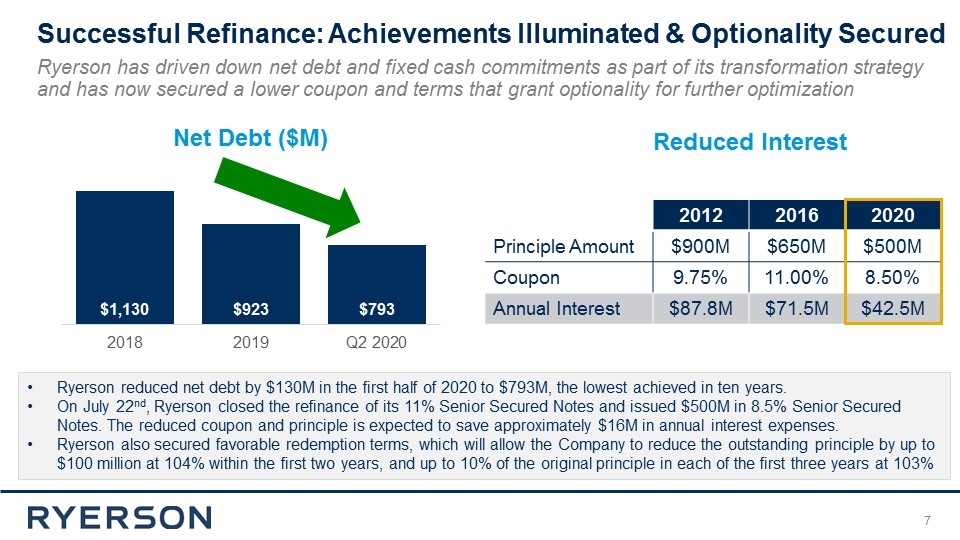
Successful Refinance: Achievements Illuminated & Optionality Secured Ryerson has driven down net debt and fixed cash commitments as part of its transformation strategy and has now secured a lower coupon and terms that grant optionality for further optimization 2012 2016 2020 Principle Amount $900M $650M $500M Coupon 9.75% 11.00% 8.50% Annual Interest $87.8M $71.5M $42.5M Ryerson reduced net debt by $130M in the first half of 2020 to $793M, the lowest achieved in ten years. On July 22nd, Ryerson closed the refinance of its 11% Senior Secured Notes and issued $500M in 8.5% Senior Secured Notes. The reduced coupon and principle is expected to save approximately $16M in annual interest expenses. Ryerson also secured favorable redemption terms, which will allow the Company to reduce the outstanding principle by up to $100 million at 104% within the first two years, and up to 10% of the original principle in each of the first three years at 103% Net Debt ($M) Reduced Interest
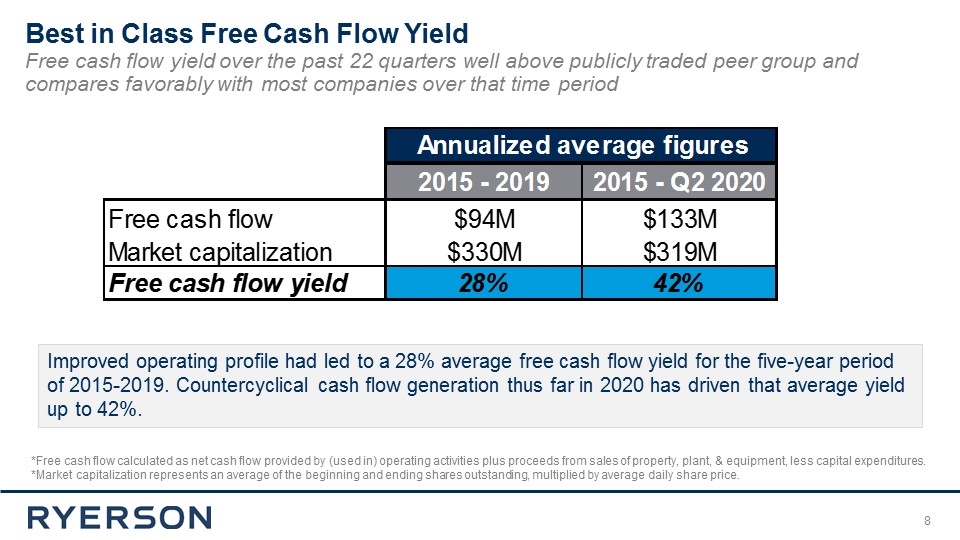
Best in Class Free Cash Flow Yield Free cash flow yield over the past 22 quarters well above publicly traded peer group and compares favorably with most companies over that time period Improved operating profile had led to a 28% average free cash flow yield for the five-year period of 2015-2019. Countercyclical cash flow generation thus far in 2020 has driven that average yield up to 42%. *Free cash flow calculated as net cash flow provided by (used in) operating activities plus proceeds from sales of property, plant, & equipment, less capital expenditures. *Market capitalization represents an average of the beginning and ending shares outstanding, multiplied by average daily share price.
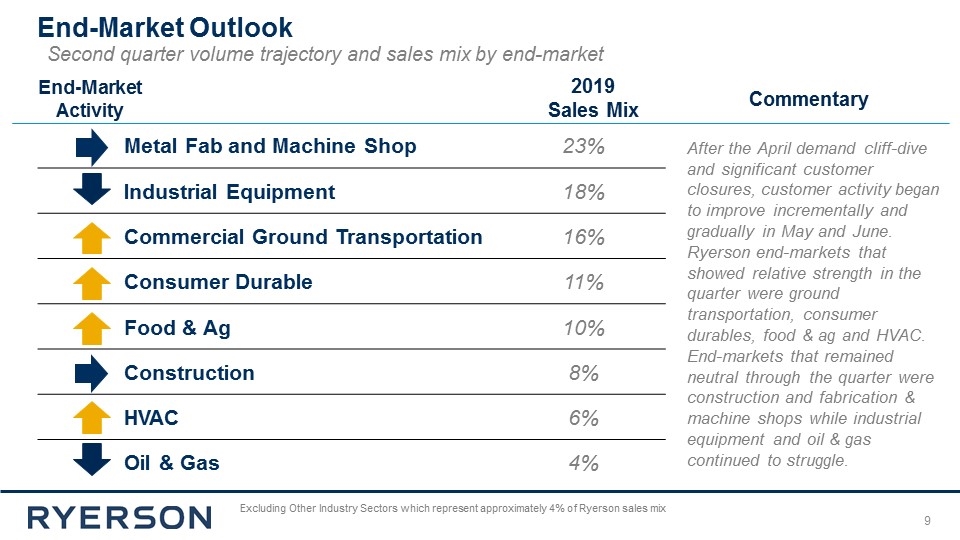
Second quarter volume trajectory and sales mix by end-market Metal Fab and Machine Shop 23% Industrial Equipment 18% Commercial Ground Transportation 16% Consumer Durable 11% Food & Ag 10% Construction 8% HVAC 6% Oil & Gas 4% Excluding Other Industry Sectors which represent approximately 4% of Ryerson sales mix After the April demand cliff-dive and significant customer closures, customer activity began to improve incrementally and gradually in May and June. Ryerson end-markets that showed relative strength in the quarter were ground transportation, consumer durables, food & ag and HVAC. End-markets that remained neutral through the quarter were construction and fabrication & machine shops while industrial equipment and oil & gas continued to struggle. 2019 Sales Mix Commentary End-Market Activity End-Market Outlook
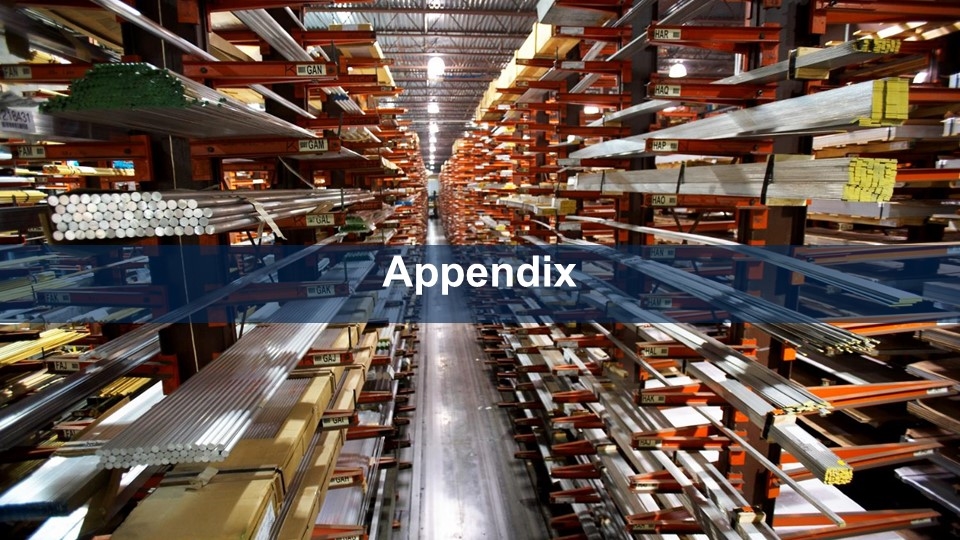
Appendix
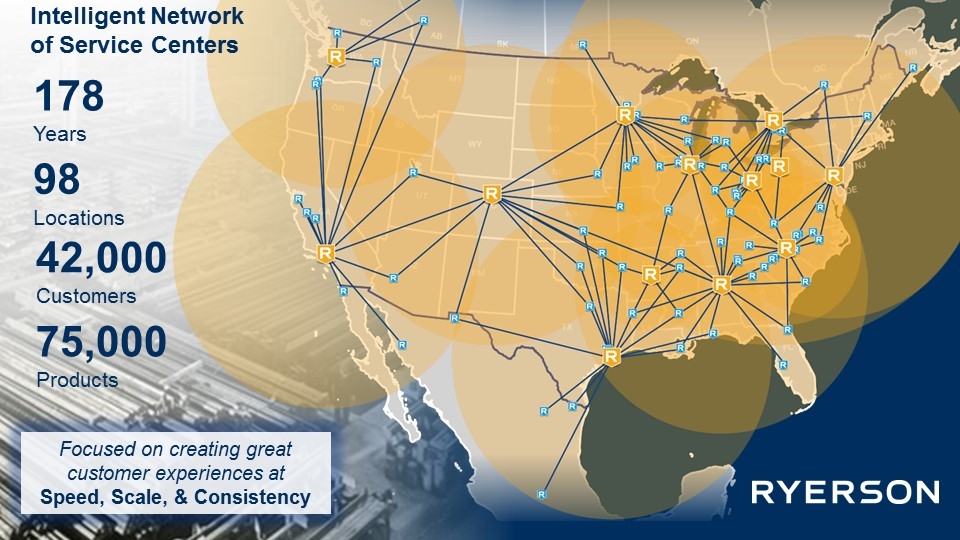
98 Locations 178 Years 42,000Customers 75,000 Products Focused on creating great customer experiences at Speed, Scale, & Consistency Intelligent Network of Service Centers
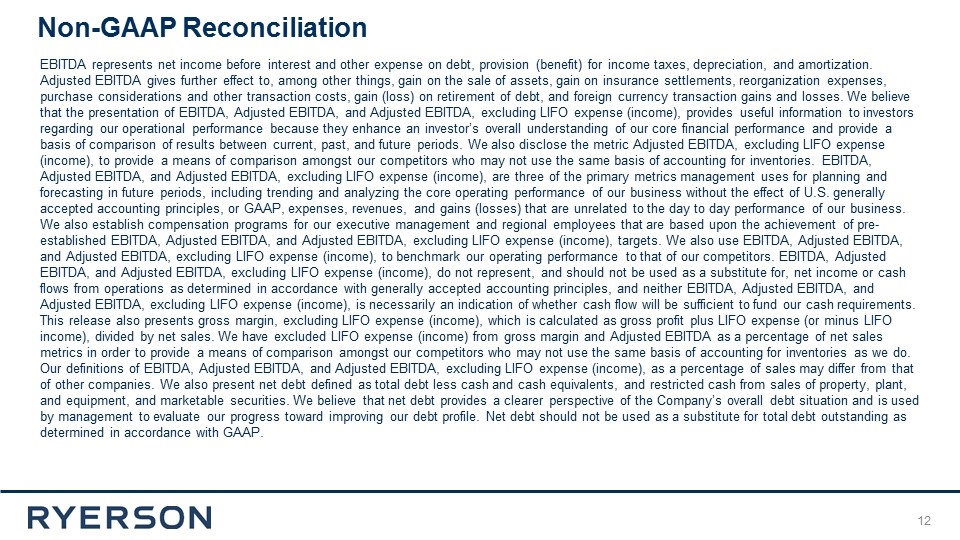
31 EBITDA represents net income before interest and other expense on debt, provision (benefit) for income taxes, depreciation, and amortization. Adjusted EBITDA gives further effect to, among other things, gain on the sale of assets, gain on insurance settlements, reorganization expenses, purchase considerations and other transaction costs, gain (loss) on retirement of debt, and foreign currency transaction gains and losses. We believe that the presentation of EBITDA, Adjusted EBITDA, and Adjusted EBITDA, excluding LIFO expense (income), provides useful information to investors regarding our operational performance because they enhance an investor’s overall understanding of our core financial performance and provide a basis of comparison of results between current, past, and future periods. We also disclose the metric Adjusted EBITDA, excluding LIFO expense (income), to provide a means of comparison amongst our competitors who may not use the same basis of accounting for inventories. EBITDA, Adjusted EBITDA, and Adjusted EBITDA, excluding LIFO expense (income), are three of the primary metrics management uses for planning and forecasting in future periods, including trending and analyzing the core operating performance of our business without the effect of U.S. generally accepted accounting principles, or GAAP, expenses, revenues, and gains (losses) that are unrelated to the day to day performance of our business. We also establish compensation programs for our executive management and regional employees that are based upon the achievement of pre-established EBITDA, Adjusted EBITDA, and Adjusted EBITDA, excluding LIFO expense (income), targets. We also use EBITDA, Adjusted EBITDA, and Adjusted EBITDA, excluding LIFO expense (income), to benchmark our operating performance to that of our competitors. EBITDA, Adjusted EBITDA, and Adjusted EBITDA, excluding LIFO expense (income), do not represent, and should not be used as a substitute for, net income or cash flows from operations as determined in accordance with generally accepted accounting principles, and neither EBITDA, Adjusted EBITDA, and Adjusted EBITDA, excluding LIFO expense (income), is necessarily an indication of whether cash flow will be sufficient to fund our cash requirements. This release also presents gross margin, excluding LIFO expense (income), which is calculated as gross profit plus LIFO expense (or minus LIFO income), divided by net sales. We have excluded LIFO expense (income) from gross margin and Adjusted EBITDA as a percentage of net sales metrics in order to provide a means of comparison amongst our competitors who may not use the same basis of accounting for inventories as we do. Our definitions of EBITDA, Adjusted EBITDA, and Adjusted EBITDA, excluding LIFO expense (income), as a percentage of sales may differ from that of other companies. We also present net debt defined as total debt less cash and cash equivalents, and restricted cash from sales of property, plant, and equipment, and marketable securities. We believe that net debt provides a clearer perspective of the Company’s overall debt situation and is used by management to evaluate our progress toward improving our debt profile. Net debt should not be used as a substitute for total debt outstanding as determined in accordance with GAAP. Non-GAAP Reconciliation
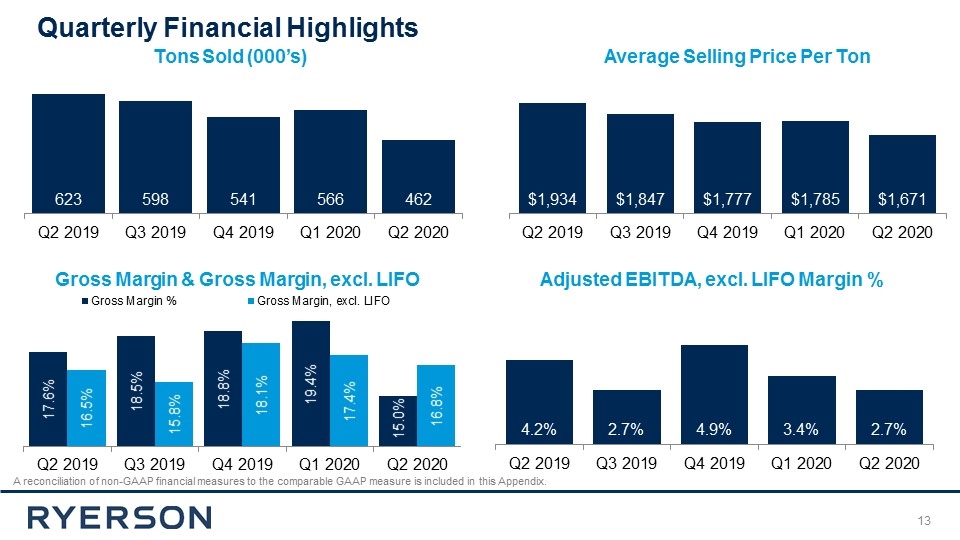
Quarterly Financial Highlights A reconciliation of non-GAAP financial measures to the comparable GAAP measure is included in this Appendix. Tons Sold (000’s) Average Selling Price Per Ton Adjusted EBITDA, excl. LIFO Margin % Gross Margin & Gross Margin, excl. LIFO
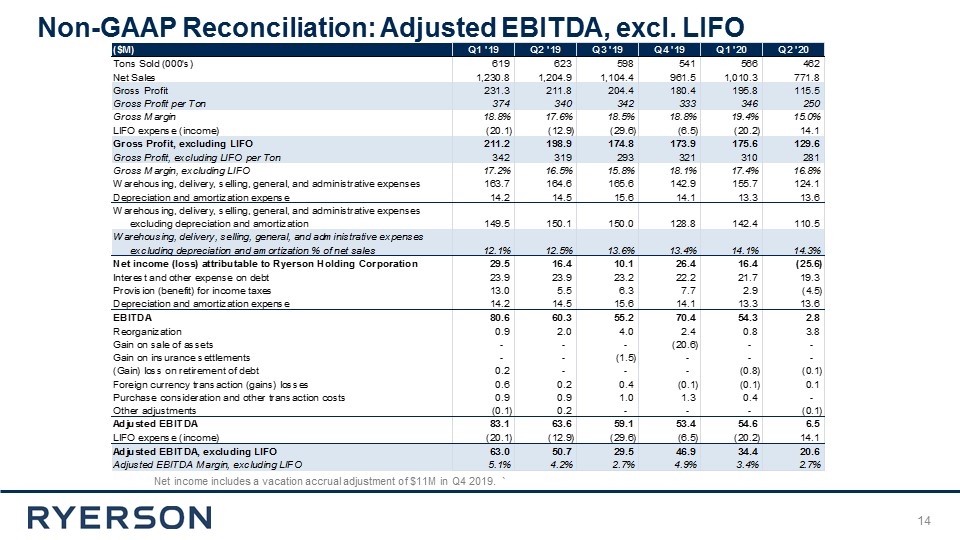
Net income includes a vacation accrual adjustment of $11M in Q4 2019. ` Non-GAAP Reconciliation: Adjusted EBITDA, excl. LIFO
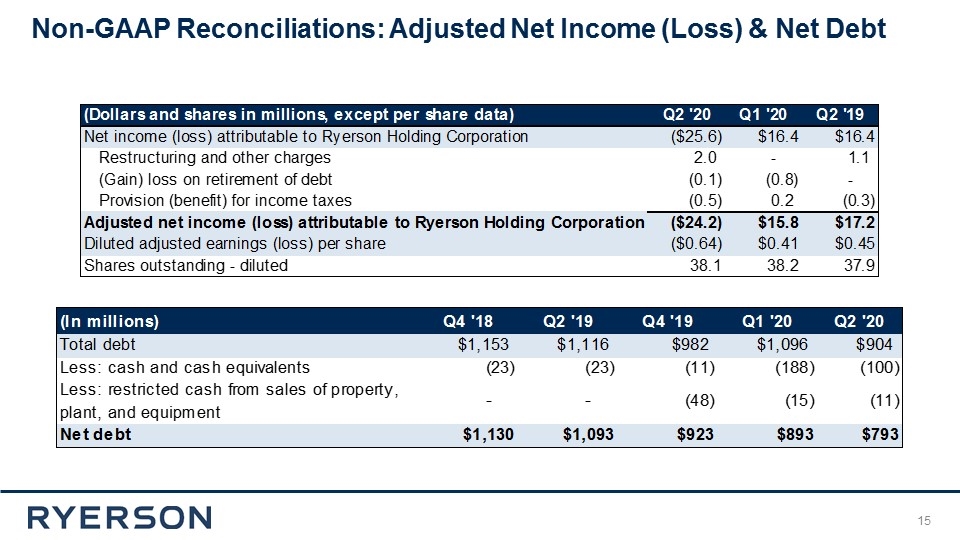
Non-GAAP Reconciliations: Adjusted Net Income (Loss) & Net Debt
